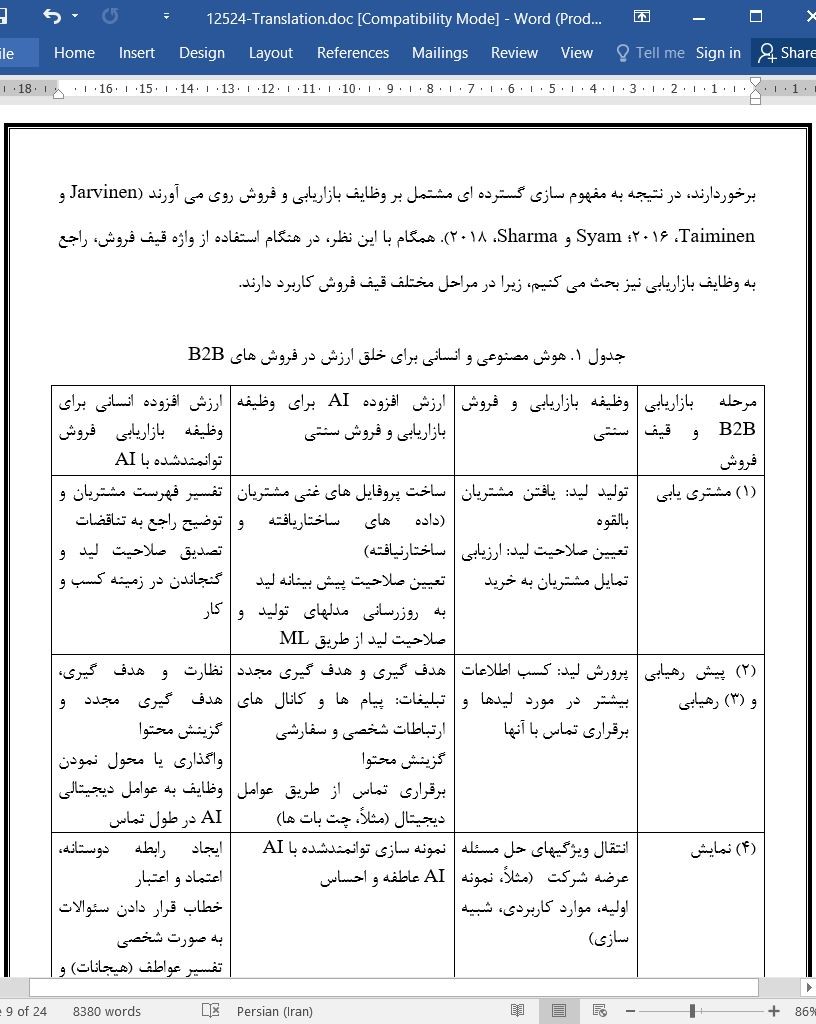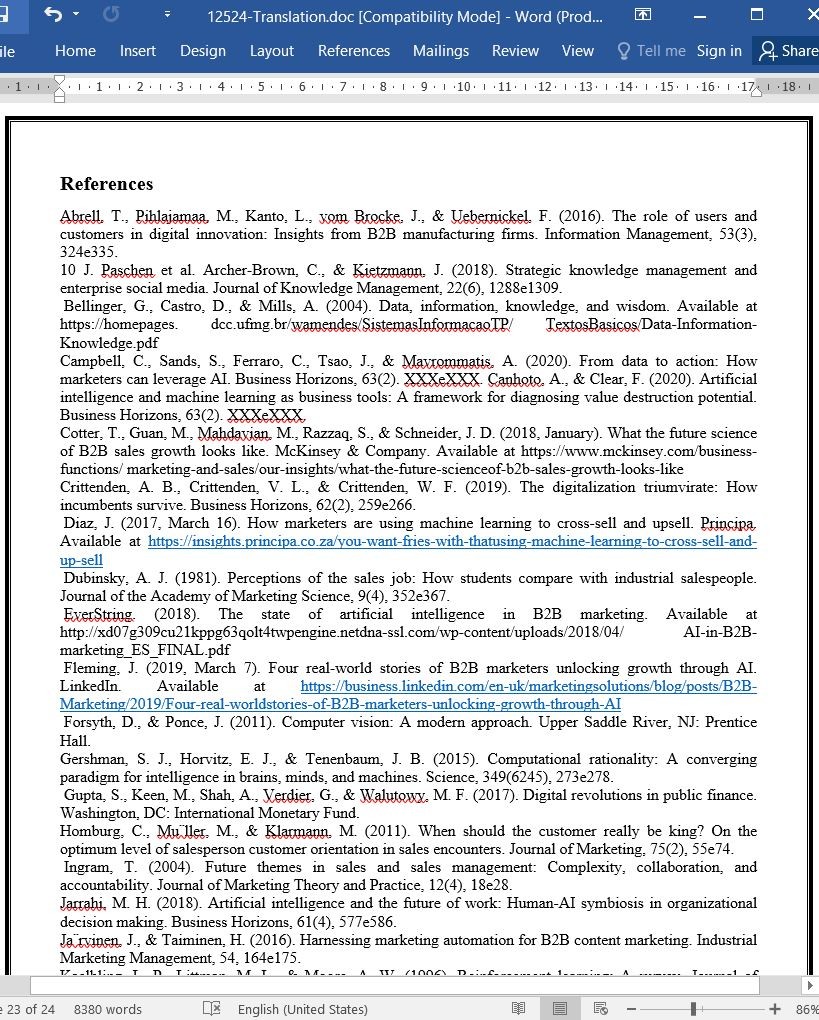
دانلود مقاله چگونه هوش انسانی و مصنوعی در امتداد قیف فروش B2B ارزش خلق می کنند
چکیده
پیشرفتهای صورت گرفته در فناوری اطلاعات و ارتباطات، به ویژه در زمینه هوش مصنوعی (AI)، موجب تغییر و تحولاتی در فرایند فروش B2B شده است. فرض و اصل Al تبدیل مقادیر وسیعی از داده ها به اطلاعات جهت خلق و مدیریت دانش در بخش فروش B2B می باشد. در این راستا، AI فرایند فروش انسان محور سنتی را به طور چشمگیری تغییر می دهد. در این مقاله،چگونگی تاثیرگذاری AI بر قیف فروش B2B را شرح می دهیم. برای هر مرحله از قیف، وظایف کلیدی فروش را شرح داده، راجع به کارهای خاص AI توضیح داده و نقش انسانها را روشن می کنیم. در این راستا، ملاحظات مدیریتی برای به حداکثررساندن همکاریهای AI و افراد در زمینه فروش B2B، را نیز مطرح می کنیم.
و زمانی که آن را دیدم، فهمیدم که فروش بزرگترین حرفه ای بود که مرد خواهان آن بود. چه عاملی می توانست به او این قدرت را بدهد که در سن 84 سالگی به 20 یا 30 شهر متفاوت رفته و تلفن را برداشته، از سوی افراد مختلف زیادی به خاطر آورده شده، به او عشق ورزیده شده و کمک شود؟
Willy Loman، Act II، در مرگ Arthur Miller فروشنده
1. آیا AI می تواند به عملکرد فروش کمک کند و در آن سهم داشته باشد؟
مدیران فروش B2B همیشه و در هر مرحله ازفروش ، نگران خدمت کردن به مشتریانشان بوده اند. با این حال، از زمان حضور فروشنده کلیشه ای Willy Loman، پروتاگونیست بازی مرگ فروشنده سال 1949 Arthur Miller، تغییرات زیادی صورت گرفته است. طبق نقل قول اول مقاله، Loman به شهرهای زیادی مسافرت نمود، جاهایی که می توانست بر روابط شخصی، عاطفی و حرفه ای با مشتریانش تکیه کند. در این فرایند، Loman و فروشندگان پیرو او برای اینکه بتوانند فروش B2B را توانمند نمایند، بر فناوریهای دستی آنالوگ (مثلاً، نقشه ها، تلفن های خط ثابت) تکیه نمودند.
5. AI بهبود خواهد بخشید، جایگزین نمی کند
AI آماده است تا در فرایند فروش B2B یک سری تغییرات بنیادی ایجاد کند. این قبیل تغییرات عمیق طبیعت کار انسانی، به ویژه هوش و تصمیم گیری انسانی را تحت تاثیر قرار خواهد داد (Syam و Sharma، 2018). متخصصین فروش B2B از سوی AI مورد حمایت واقع شده و حتی از برخی وظایفی که قبلاً توسط افراد انجام می شدند، دست می کشند. مشکل آن است که مدیران اجرایی مشتاق برای پذیرش این فناوریهای جدید در مورد کارهای AI در فرایند فروش B2B و نقش متخصصین فروش در قیف فروش توانمند شده با AI مطمئن نیستند. این درک که در زمان پذیرش AI حتی بحرانی و حساس تر ظاهر می شود، به معنای صرف نظرکردن و دست کشیدن از درجه ای از تصمیم گیری و کنترل انسانی می باشد.
در این وضعیت، مقاله حاضر راجع به کارهای سیستم های AI در جهت خلق ارزش افزوده در هر مرحله از قیف فروش و همچنین راجع به نقش هوش و تصمیم گیری انسانی در هر مرحله از قیف فروش توانمندشده با AI توضیح می دهد. امیدواریم مقاله حاضر در مورد کمال انسانها و AI رویکردی جامع ارائه دهد (Jarrahi، 2018). I، با ظرفیت پردازش اطلاعات عظیمش، می تواند هوش انسانی را تقویت نموده یا حتی جایگزین وظایف انسانی درست تعریف شده و تکرارشدنی در فروش B2B شود. از طرف دیگر، انسانها در زمینه استفاده از درک و شهود برای مقابله با اطلاعات متناقض یا غیر قطعی، دستیابی به بینش ها و مفاهیم مرتبط با کسب و کار، و در جنبه های رابطه سازی برتر در فروش B2B، برتری دارند. طبق اظهارات Willy Loman، اساساً، حتی در زمان های تغییر و تحول عمیق نیز هدف نهایی متخصصین فروش، کمک به مشتریان در تامین نیازهایشان می باشد. آنچه تغییر کرده است، نحوه دستیابی به هدف نهایی و نحوه پشتیبانی فناوریهای درحال ظهور، به ویژه AL از فروشندگان در دستیابی به این هدف با تبدیل داده های بزرگ به اطلاعات و نهایتاً دانش می باشد.
Abstract
The B2B sales process is undergoing substantial transformations fueled by advances in information and communications technology, specifically in artificial intelligence (AI). The premise of AI is to turn vast amounts of data into information for superior knowledge creation and knowledge management in B2B sales. In doing so, AI can significantly alter the traditional human-centric sales process. In this article, we describe how AI affects the B2B sales funnel. For each stage of the funnel, we describe key sales tasks, explain the specific contributions AI can bring, and clarify the role humans play. We also outline managerial considerations to maximize the contributions from AI and people in the context of B2B sales.
“And when I saw that, I realized that selling was the greatest career a man could want. ’Cause what could be more satisfying than to be able to go, at the age of 84, into 20 or 30 different cities, and pick up a phone, and be remembered and loved and helped by so many different people?”
-Willy Loman, Act II, in Arthur Miller’s Death of a Salesman’
1. Can AI contribute to sales performance?
B2B sales managers have always been concerned with serving their clients at every stage of the sales process. However, much has changed since the days of stereotypical salesperson Willy Loman, the protagonist in Arthur Miller’s 1949 play Death of a Salesman. As the opening quote reveals, Loman’s travels took him to many cities in which he could rely on personal, emotional, and professional connections with his clients. In the process, Loman and his fellow salespeople mainly relied on manual, analog technologies (e.g., maps, landline telephones) to enable their B2B sales.
5. AI will enhance, not replace
AI is poised to set off a series of fundamental changes to the B2B sales process. These profound changes will affect the nature of human work, specifically human intelligence and decision making (Syam & Sharma, 2018). B2B sales professionals will be supported by AI and may even relinquish some of the tasks previously performed by people. The trouble is that executives eager to adopt these new technologies are unclear about the contributions that AI may bring to the B2B sales process and the role that sales professionals play in the AI-enabled sales funnel. This understanding is even more critical when adopting AI means relinquishing some degree of human decision making and control.
Against this backdrop, our article explicates the value-add contributions of AI systems at each stage of the sales funnel, in addition to clarifying the role that human intelligence and decision making play at each stage of the AI-enabled sales funnel. We hope that our article provides a comprehensive perspective on the complementarity (Jarrahi, 2018) of humans and AI. AI, with its enormous information processing capacity, can augment human intelligence or even replace welldefined and repeatable human tasks in B2B sales. On the other hand, humans still hold an upper hand in using intuition to deal with contradictory or uncertain information and to derive insights and implications related to their business and in the relationship-building aspects that are paramount in B2B sales. In essence, even in times of profound transformation, the ultimate goal of sales professionals is to help customers satisfy their needs, as the character Willy Loman suggested. What has changed is how the end goal is achieved and how emerging technologies, specifically AI, can support salespeople in achieving this goal by turning big data into information and, ultimately, knowledge.
چکیده
1. آیا AI می تواند به عملکرد فروش کمک کند و در آن سهم داشته باشد؟
2. بنیان های AI
2.1. ورودیها
2.2. فرایندها
2.3. خروجیها
3. قیف فروش B2B توانمند شده با AI
3.1. مشتری یابی
3.2. پیش رهیابی و رهیابی (رسیدن)
3.3. نمایش
3.4. غلبه بر اعتراضات و خاتمه عملیات
3.5. پیگیری
4. ملاحظات مدیریتی برای به حداکثر رساندن هوش مشارکتی
4.1. آموزش ضروری است
4.2. پیوند AI با استراتژیها و تاکتیک های مدیریت دانش سازمانی
4.3. محول نمودن بینش ها و وظایف اجتماعی / عاطفی به هوش انسانی
4.4. پشتیبانی از مشتریان از طریق گذار
4.5. انتظار مقاومت
4.6. امنیت اطلاعات برتر است
4.7. ساخت یک ساختار نیروی فروش و فرایندهای حامی AI
5. AI بهبود خواهد بخشید، جایگزین نمی کند
منابع
Abstract
1. Can AI contribute to sales performance?
2. Foundations of AI
2.1. Inputs
2.2. Processes
2.3. Outputs
3. The AI-enabled B2B sales funnel
3.1. Prospecting
3.2. Pre-approach and approach
3.3. Presentation
3.4. Overcoming objections and closing
3.5. Follow-up
4. Managerial considerations for maximizing collaborative intelligence
4.1. Training is essential
4.2. Link AI to enterprise knowledge management strategies and tactics
4.3. Leave insights and social/emotional tasks to human intelligence
4.4. Support customers through the transition
4.5. Expect resistance
4.6. Information security is paramount
4.7. Build a sales force structure and processes supportive of AI
5. AI will enhance, not replace
References
- اصل مقاله انگلیسی با فرمت ورد (word) با قابلیت ویرایش
- ترجمه فارسی مقاله با فرمت ورد (word) با قابلیت ویرایش، بدون آرم سایت ای ترجمه
- ترجمه فارسی مقاله با فرمت pdf، بدون آرم سایت ای ترجمه



